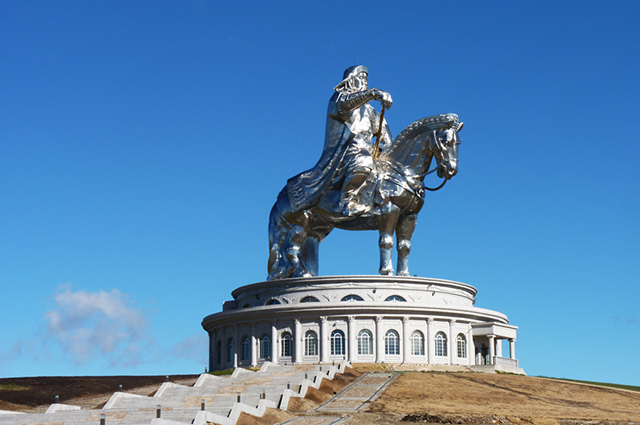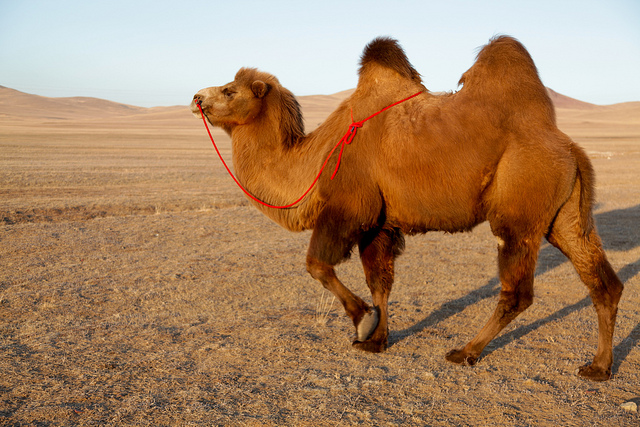Last updated on April 18th, 2022
About Genghis Khan (Chinggis Khaan)
43. Genghis Khan is just the title. His real name was Temujin. He conquered 12 million square miles of territory before his death on August 18, 1227. He was born in 1162.
44. Prior to 1206, tribes in Mongolia were scattered. However, it was Genghis Khan who brought all the tribes together and formed a unified state. This had a long-lasting positive impact on the lives of a huge chunk of individuals at the time.
45. It is estimated that during the time of Genghis Khan, more than 40 million people died due to his campaigns of acquiring other territories.

46. A giant statue of Genghis Khan riding a horse, forty meters high, was erected in 2008. It is the world’s largest equestrian statue, and it cost nearly 4 million USD to build the same. Two hundred and fifty tons of stainless steel was used to build the statue which has an elevator to take visitors and tourist to the top of the horse’s head.
47. The burial site of Genghis Khan is a secret to this day. It is said that the burial attendees were killed by the soldier who also killed themselves in an attempt to keep the location of the site a secret, and why this was done is a question till date.
Some interesting facts about Mongolia
48. Mongolia is also known as “Land of the Eternal Blue Sky”. This title is given to Mongolia because it receives 250 days and more of sunshine every year.
49. Mongolians are nomadic and almost 30-40% of the population is expected to be living their lives this way.
50. A typical Mongolian nomadic house is made from a wooden frame structure and felt. The material is light in weight so that it helps during transportation by camels.
51. Living nomadic life could be hard for anyone but not for Mongolians. They have developed special characteristics and qualities that help them survive under such harsh conditions.

52. Talking about the camels, take a note that Mongolia is also home to a double-humped camel – The Bactrian camel. These camels can be seen in the Gobi Desert and near some nomadic establishments. Learn more…
53. Interestingly, the Bactrian Camel can survive in temperatures ranging between minus 50 and plus fifty degree Celsius. The only other place except for Mongolia where these camels can be seen is China.
54. Horses are also of paramount importance in present-day Mongolia and in the history of the country as well. Mongolia is also known as the “Land of the Horsemen”.
55. Today horses are used as a mode of transportation and were also used extensively by Genghis Khan’s army to conquer various territories.
56. Horses were also used for delivering messages throughout Mongolia some 1000 years ago. There were different stations and the postal service was known as “Yam” during the time.
57. In the Yam system of messaging, horses from one station would deliver messages to the next station and rest, and horses from the second station would deliver the messages to the third station and rest there, and so on so forth. Hence, the messages were constantly on the move without the horsemen and horses getting tired. This system facilitated quicker delivery of the messages. Each station was usually 14 to 40 miles apart. The system played a key role in the political and economic stability of the vast Mongol Empire. The system created by Genghis Khan became one of the first international postal systems.
58. The presidency of the first president of Mongolia–Navaandorjiin Jadambaa–lasted one day after he became the president of the country in 1924. He was replaced by Peljidiin Genden.
59. The first writing system of Mongolia was commissioned by Genghis Khan, who could not write or read.
60. It is estimated that modern humans reached Mongolia almost 40,000 years ago.
61. As of today, more Mongolians live in the People’s Republic of China (the Inner Mongolia Autonomous Region) than in Mongolia.
62. Mongolians experience harsh conditions during the winter.
63. Mongolia is also home to Takhi Horse, a kind of a wild horse.
64. The fifth largest desert in the world and the largest in Asia, the Gobi Desert, lie in Mongolia. In the past, the Gobi was a sea and now a site of marine fossils.
65. In 1924, Mongolia became a communist country.
66. Mongolia is also one of the safest countries in the world for visitors.
67. In 2006, Mongolia passed an anti-corruption legislation.
Mongolia – country at a glance
| Independence | 29 December 1911 (from China) |
|---|---|
| Capital City | Ulaanbaatar (47°55′N 106°53′E) |
| Largest City | Ulaanbaatar (47°55′N 106°53′E) |
| Area | total: 1,564,116 sq km land: 1,553,556 sq km water: 10,560 sq km (slightly smaller than Alaska; more than twice the size of Texas) |
| Population | 3,281,676 (2024 est.) |
| Demonym | Mongolian Mongol (used mainly for historical purposes) |
| Official Language | Mongolian |
| National Anthem | "Mongol ulsyn toriin duulal" (National Anthem of Mongolia) |
| Religion | Buddhism (50%) Irreligion (38.6%) Islam (6%) Shamanism (2.9%) |
| Borders | China and Russia |
| Currency | Tögrög (MNT) |
| Government type | semi-presidential republic |
| President | Ukhnaagiin Khürelsükh |
| Prime Minister | Luvsannamsrain Oyun-Erdene |
| Literacy (age 15 and over can read and write) | 99.2% |
| Life Expectancy at birth | 71.9 years (2024 est.) |
| National symbol | soyombo emblem |
| National colors | red, blue, yellow |
| Natural resources | oil, coal, copper, molybdenum, tungsten, phosphates, tin, nickel, zinc, fluorspar, gold, silver, iron |
| Mean elevation | 1,528 m |
| Lowest point | Hoh Nuur 560 m |
| Highest point | Nayramadlin Orgil (Khuiten Peak) 4,374 m |
| Industries | construction and construction materials; mining (coal, copper, molybdenum, fluorspar, tin, tungsten, gold); oil; food and beverages; processing of animal products, cashmere and natural fiber manufacturing |
| Exports | $15.501 billion (2023 est.) coal, copper, gold, iron, crude petroleum (2019) |
| Imports | $13.545 billion (2023 est.) refined petroleum, cars, delivery trucks, construction vehicles, aircraft (2019) |
| GDP - per capita (PPP) | $16,200 (2023 est.) |
| Birth rate | 14.9 births/1,000 population (2024 est.) |
| Death rate | 6.4 deaths/1,000 population (2024 est.) |
| Sex ratio | 0.95 male(s)/female (2024 est.) |
| Terrain | vast semidesert and desert plains, grassy steppe, mountains in west and southwest; Gobi Desert in south-central |
| Climate | desert; continental (large daily and seasonal temperature ranges) |
| Agricultural land | 73% |
| Time Zone | UTC + 7/+8 |
| Internet country code | .mn |
| Calling Code | +976 |
| Drives on the | Right |
| Table last updated | February 28, 2025 |
